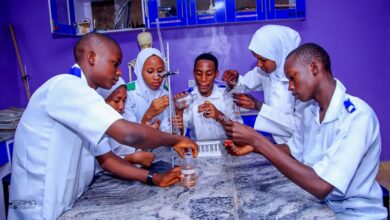NECO Chemistry Practical Questions and Answers 2023 (Specimens)

Are you preparing for the NECO Chemistry Practical exam in 2023? Do you want to ace the exam and secure a high score? Look no further! In this comprehensive guide, we will provide you with all the information you need to excel in the NECO Chemistry Practical exam. From the specimen and apparatus to the questions and answers, we’ve got you covered.
Understanding the NECO Chemistry Practical Exam
The NECO Chemistry Practical exam consists of two sections: Quantitative Analysis and Qualitative Analysis. These sections involve titration and tests of ions, respectively. It is crucial to have a clear understanding of the exam format and marking scheme before attempting any questions. This will enable you to present your answers effectively and maximize your chances of scoring high marks.
Note: This questions may not 100% accurate, This article is meant to guide students for their exams.
The NECO Chemistry Practical Specimen
To prepare for the exam, it is essential to familiarize yourself with the NECO Chemistry Practical specimen. The specimen includes various apparatus and reagents that will be used for qualitative work. Some of the commonly used reagents include dilute sodium hydroxide solution, dilute ammonia solution, dilute hydrochloric acid, and barium chloride solution. Additionally, you will need red and blue litmus paper, phenolphthalein, and methyl orange.
The apparatus required for the exam include a burette, a pipette of a specific volume (usually 20cm³ or 25cm³), a boiling tube, test tubes, and filtration apparatus. It is important to note that all candidates in a center must use pipettes of the same volume to ensure fairness in the examination.
Each candidate will be provided with labeled bottles containing specific solutions. These solutions include hydrochloric acid solution, sodium hydroxide solution, and copper (II) tetraoxosulphate (VI) salt. The concentrations and quantities of these solutions may vary, so it is critical to read the labels carefully and follow the provided instructions.
Preparing for the NECO Chemistry Practical Exam
To excel in the NECO Chemistry Practical exam, thorough preparation is key. Here are some tips to help you prepare effectively:
- Review the Syllabus: Familiarize yourself with the NECO Chemistry Practical syllabus to understand the topics and concepts that may be tested in the exam. Focus your preparation on these areas.
- Practice Past Questions: Solve past questions and practice experiments to get acquainted with the exam format and build your confidence. This will also help you identify areas where you need to improve.
- Understand Experimental Procedures: Gain a deep understanding of the experimental procedures, including the steps involved, the reagents used, and the observations to be made. This will enable you to answer questions accurately and precisely.
- Master Data Analysis: Develop your skills in analyzing experimental data, including calculations, conversions, and interpretation of results. Practice different types of calculations to ensure you are well-prepared for any scenario.
- Time Management: The NECO Chemistry Practical exam has a time limit. Practice managing your time effectively during experiments to ensure you complete all tasks within the allocated time.
- Seek Help if Needed: If you encounter any difficulties or have questions while preparing for the exam, don’t hesitate to seek help from your teachers, classmates, or online resources. Clarifying your doubts will enhance your understanding and boost your performance.
Sample Questions and Answers
Now, let’s take a look at some sample questions and answers to give you an idea of what to expect in the NECO Chemistry Practical exam:
Question 1: Titration Experiment
In this experiment, you are provided with 20.0cm³ portions of 0.065 mol dm-3 NaOH and are required to titrate them against dilute HCl. The table below shows the results of the titration:
| Burette Readings (cm³) | 1st | 2nd | 3rd | Final Reading (cm³) |
|---|---|---|---|---|
| Initial Reading (cm³) | 0.00 | 23.50 | 24.00 | |
| Volume of Acid Used (cm³) | 23.50 | 23.10 | 23.40 |
(a) (i) Name a suitable indicator for titration and give a reason for your answer.
- Answer: A suitable indicator for this titration is methyl orange. It changes color in the acidic pH range and provides a clear visual indication of the endpoint.
(ii) Give the color of the indicator in the base and at the endpoint.
- Answer: The indicator is yellow in the base and changes to red at the endpoint.
(iii) What type of reaction is demonstrated by the experiment?
- Answer: The experiment demonstrates a neutralization reaction between an acid (HCl) and a base (NaOH).
(b) (i) Write a balanced equation for the reaction.
- Answer: The balanced equation for the reaction is: NaOH(aq) + HCl(aq) -> NaCl(aq) + H2O(l)
(ii) Determine the average volume of acid used.
- Answer: The average volume of acid used is calculated by taking the average of the three titration values: (23.50 + 23.10 + 23.40) / 3 = 23.33 cm³
(c) Calculate the: (i) concentration of the acid in moldm-3 (ii) concentration of the acid in gdm-3 (iii) mass of HCl in 20cm³ of solution [H = 1.00, Cl = 35.5]
- Answer: (i) The concentration of the acid in moldm-3 can be calculated using the formula: concentration (moldm-3) = moles / volume (dm³). Since the moles of acid used are equal to the moles of NaOH, and the volume used is 23.33 cm³, which is equal to 0.02333 dm³, the concentration is: 0.065 mol dm-3.
(ii) To calculate the concentration of the acid in gdm-3, we need to convert moles to grams and divide by the volume in dm³. The molar mass of HCl is 1.00 + 35.5 = 36.5 g/mol. The concentration is: (0.065 mol dm-3) * (36.5 g/mol) = 2.3725 g dm-3.
(iii) The mass of HCl in 20 cm³ of solution can be calculated by multiplying the concentration in g dm-3 by the volume in dm³: (2.3725 g dm-3) * (0.020 dm³) = 0.04745 g.
Question 2: Qualitative Analysis Experiment
In this experiment, you are given a mixture (F) of two inorganic salts. Perform the following tests and record your observations and inferences:
(a) Add distilled water to F and stir well. Filter the mixture and keep the filtrate and residue.
- Observation: Effervescence occurs during the mixing, and a colorless and odorless gas is evolved. The filtrate is pale blue or colorless, while the residue is green.
(b) (i) Add NaOH(aq) in drops to a portion of the filtrate, followed by excess.
- Observation: A white precipitate is formed. The precipitate is insoluble in excess NaOH(aq).
- Inference: The presence of Ca2+/Pb2+ ions is confirmed.
(ii) Add a few drops of HNO3(aq) to another portion of the filtrate, followed by a few drops of AgNO3(aq).
- Observation: No visible reaction occurs.
- Inference: The absence of Cl- ions is indicated.
(c) Add NH3(aq) in drops to a portion of the residue, followed by excess.
- Observation: A white gelatinous precipitate is formed. The precipitate dissolves in excess NH3(aq).
- Inference: The presence of Cu2+ ions is confirmed.
(d) (i) Add HNO3(aq) to the residue obtained from 2(c).
- Observation: Effervescence occurs, and a colorless and odorless gas is evolved. The gas turns blue litmus paper to red and lime water milky.
- Inference: The presence of CO32- ions is indicated.
(ii) To distinguish between Zn(OH)2 and Ca(OH)2, which are both white substances, a suitable reagent would be required. The reagent is not specified in the question.
- Additional Information: A suitable reagent to distinguish between Zn(OH)2 and Ca(OH)2 is NaOH(aq). Zn(OH)2 is insoluble in excess NaOH(aq), while Ca(OH)2 dissolves to form a clear solution.
Question 3: Observations in Laboratory Reactions
Predict the observations for the following reactions in the laboratory:
(i) Methyl orange is dropped into a solution of lime juice.
- Answer: The solution of lime juice will turn pink or red.
(ii) Hydrogen sulphide gas is bubbled through iron (III) chloride solution.
- Answer: The iron (III) chloride solution will change color from brown to green, and a yellow deposit may form.
(iii) Sulphur (IV) oxide gas is bubbled into an acidified solution of KMnO4.
- Answer: The purple color of the KMnO4 solution will turn colorless or decolorized.
(iv) Ethanoic acid is added to a solution of K2CO3.
- Answer: Bubbling of effervescence will occur, and a colorless, odorless gas will be evolved.
Conclusion
With this comprehensive guide, you are now equipped with the knowledge and understanding to excel in the NECO Chemistry Practical exam in 2023. Remember to practice past questions, familiarize yourself with the specimen and apparatus, and develop your skills in experimental procedures and data analysis. By following these tips and preparing effectively, you can confidently approach the exam and achieve a high score. Good luck!













Neco 2023 Chemistry Practical Question And Answer Now Available!!!
IF YOU NEED THE ANSWER ON WHATSAPP IS AVAILABLE, IT COST #800… ADD US ON WHATSAPP WITH =>
09035742503
09035742503
09035742503
I appreciate this
Wow I am interested!
Wow….! I am in please how can I pay hope is not scam?